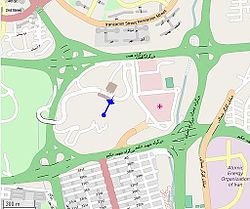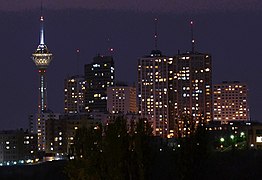Milad Tower
| Milad Tower | |
|---|---|
Borj e Milād | |
| File:Borje Milad 17 March 2016.jpg | |
 Location within Tehran (dark blue) | |
| Alternative names | Tehran Tower |
| General information | |
| Status | Completed |
| Type | Concrete, commercial, telecommunication, observation, restaurant, hotel |
| Location | Tehran, |
| Coordinates | 35°44′41″N 51°22′31″E / 35.74472°N 51.37528°E |
| Construction started | 2000 |
| Completed | 2009 |
| Opening | 2009 |
| Management | Boland Payeh Co. |
| Height | |
| Antenna spire | 435.0 m (1,427 ft) |
| Roof | 315.0 m (1,033 ft) |
| Top floor | 312.0 m (1,024 ft) |
| Technical details | |
| Floor count | 12 |
| Floor area | 154,000 m2 (1,660,000 sq ft) |
| Lifts/elevators | 7 |
| Design and construction | |
| Architect(s) | Mohammad Reza HAFEZI |
| Main contractor | Boland Payeh Co. |
| References | |
| [1][2][3] | |
Milad Tower (Template:Lang-fa), also known as the Tehran Tower ([برج تهران – Borj e Tehrān] Error: {{Lang}}: text has italic markup (help)),[3] is a multi-purpose tower in Tehran, Iran. It is the sixth-tallest tower[4] and the 17th-tallest freestanding structure in the world.[5]
It is located between the Qarb Town and Gisha District, standing at 435 metres from base to the tip of the antenna.[6] The head consists of a large pod with 12 floors, the roof of which is at 315 m.
The tower is a part of a complex called International Trade and Convention Center of Tehran. The complex also includes a five-star hotel, a convention center, a world trade center, and an IT park.[1][2][3]
History
The tower was first proposed as part of the "Shahestan Pahlavi" project, in Tehran's Abbas Abad district, and was designed by the American urban planner Jaquelin Robertson.[7] The site was planned to encompass five million square meters, a third of which was to be open space,[8] and to accommodate 50,000 residents, as well as government ministries, commercial offices, and a number of cultural centers, including museums, facilities for the performing arts, and libraries.[8] The project would have cost $5 billion ($21 billion adjusted for inflation).[8] The firm also employed Lisa Halaby, the future Queen Noor of Jordan.[7] After the 1979 Revolution, the project was cancelled.
Resumption of Construction
Construction of the tower was commenced in 1997. Upon completion of its 11-year-long construction in 2008, the Milad Tower was considered the fourth-tallest free-standing telecommunication tower in the world.[3] The tower was opened a year later, in 2008, albeit numerous conflicts on the history of the tower still prevail, such as some sources proving that commencement of the tower's construction was a year earlier instead of 2000 and that the tower was completed a year later instead of 2007.[1][2][3] The tower was officially opened on 20 February 2009 by the 55th Mayor of Tehran, Mohammad-Bagher Ghalibaf, and members of the City Council of Tehran. More than 250 local and foreign journalists were covering the event.
Structure and features


Milad Tower, with its height of 435 m (1,427 ft), is the tallest tower in Iran, and the sixth-tallest telecommunication tower in the world. It consists of five main parts, including the foundation, transition (lobby) structure, shaft, head structure and the antenna mast.
The lobby structure consists of six floors. The first three floors consist of 63 trade units, 11 food courts, a cafeteria, and a commercial products exhibition which is supposed to be 260 m2 (2,800 sq ft).[3] The first and second floors underground consist of official and installing sections and data center. The ground floor is devoted to the entrance and visitors reception.
The shaft is a concrete structure which is 315 m-high (1,033 ft) from the ground floor. In three different sides of it, 6 elevators are used to transfer the visitors to the head of the tower at the speed of 7 m/s (0.0070 km/s), and there is an emergency staircase exists at the fourth side.
The head of the tower is a steel structure weighing about 25,000 tonnes and consisting of 12 floors. In the top floors of the tower, fire-immune areas were built as a refuge zone,[9] a closed observation deck, a cafeteria, a public art gallery, an open observation deck, a revolving restaurant, telecommunication floors, a VIP restaurant, mechanical floors, and a sky dome.[2]
The four-stage antenna mast is 120 m-high (390 ft). The lower floor of the mast is for the adjustment of public users' telecommunication antennas and the three upper floors are devoted to the antenna of radio and television organisation of the Islamic Republic of Iran.[2][3]
Furthermore, the complex features a parking area of 27,000 m2 (290,000 sq ft), a large computer and telecommunications unit, a cultural and scientific unit, a commercial transaction centre, a temporary showroom for exhibiting products, a specialised library, an exhibition hall, and an administrative unit. Milad Tower has an octagonal base, symbolising traditional Persian architecture.[2]
The design of the project was conducted by Dr. Mohammad Reza Hafezi, since he has been known as the architect and the head of design of the project. The tower was built by Boland Payeh Company as the general contractor, and customized by Yadman Sazeh Company, the representative of the Tehran Municipality as the main client and investor.[2]
International Convention Center
The center's main parts are seven conference salons and an exhibition space with an area of 700 m2 (7,500 sq ft), and its other features are a lobby, a training room, two powder rooms, a radio and television studio, and reception services.[2][3]
International Hotel
A five-star hotel with an area of 52,000 m2 (560,000 sq ft) has been established in order to provide local and global tourists and the guests attending the conventions with accommodation and reception services.
World Trade Center
This center, with an area of 40,000 m2 (430,000 sq ft), has been established with different sections for national and global commercial business transactions, exhibitions for products and services, technical and scientific conventions.
-
Milad Tower under construction
-
Entrance to the tower
-
Milad Tower seen from Qarb Town
-
Milad Tower seen from Hemmat Highway
-
Milad Tower and the statue of Ferdowsi
Ranks
- Fifth-tallest tower in Southwest Asia
- World's 6th-tallest freestanding telecommunication tower upon completion
- World's 17th-tallest freestanding structure
See also
- List of tallest towers in the world
- List of tallest buildings and structures in the world
- List of tallest freestanding structures in the world
- List of tallest towers in Southwest Asia
- List of tallest buildings in Tehran
- Fernsehturm Stuttgart – first TV tower built from concrete and prototype
- List of revolving restaurants
- International rankings of Iran
- A.S.P. Towers
References
- ^ a b c "Borj-e Milad, Tehran - SkyscraperPage.com". Skyscraperpage.com. Retrieved 2012-12-29.
- ^ a b c d e f g h Zafarani, H. "Seismic Response Analysis of Milad Tower in Tehran, Iran, UNDER SITE-SPECIFIC SIMULATED GROUND MOTIONS" (PDF). Iitk.ac.in. Retrieved 2012.
{{cite web}}: Check date values in:|accessdate=(help) - ^ a b c d e f g h "Milad Tower | Buildings". Emporis.com. Retrieved 2012-12-29.
- ^ "Milad Tower, a perfect product for a perfect project". NBN (Nasl Bartar Novin). n.d. Archived from the original on November 17, 2009. Retrieved 2009-09-10.
{{cite web}}: Unknown parameter|deadurl=ignored (|url-status=suggested) (help) - ^ Andrew Burke, Mark Elliott. Iran (Lonely Planet Country Guide). p. 114. Lonely Planet Publications, 5th Edition, 2008. ISBN 978-1-74104-293-1.
- ^ "Iran Opens World's 4th Highest Telecoms Tower". Cellular-News. 2009-09-08. Retrieved 2009-10-05.
- ^ a b Vanstiphout, Wouter. "The Saddest City in the World". The New Town. Retrieved 1 June 2013.
- ^ a b c Khoshnood, Ardavan. "Shahestan Pahlavi". Aryamehr.com. Retrieved 1 June 2013.
- ^ "Congress Venue". IUA. 2009-03-13. Retrieved 2009-10-05.





